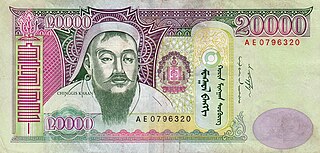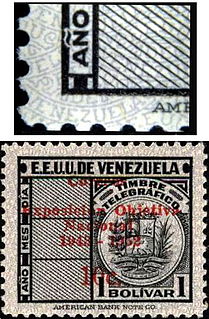
The kwacha is the currency of Zambia. It is subdivided into 100 ngwee.

The tenge is the currency of Kazakhstan. It is divided into 100 tıyn. The ISO-4217 code is KZT.

The Brunei dollar, has been the currency of the Sultanate of Brunei since 1967. It is normally abbreviated with the dollar sign $, or alternatively B$ to distinguish it from other dollar-denominated currencies. It is divided into 100 sen (Malay) or cents (English). The Brunei dollar is issued by the Autoriti Monetari Brunei Darussalam.

The córdoba is the currency of Nicaragua. It is divided into 100 centavos.

The birr is the unit of currency in Ethiopia. Before 1976, dollar was the official English translation of birr. Today, it is officially birr in English as well.

The lira was the currency of Italy between 1861 and 2002 and of the Albanian Kingdom between 1941 and 1943. Between 1999 and 2002, the Italian lira was officially a national subunit of the euro. However, cash payments could be made in lira only, as euro coins or notes were not yet available. The lira was also the currency of the Napoleonic Kingdom of Italy between 1807 and 1814.

The tögrög or tugrik is the official currency of Mongolia. It was historically subdivided into 100 möngö (мөнгө). Currently, the lowest denomination in regular use is the 10-tögrög note and the highest is the 20,000-tögrög note. In unicode, the currency sign is U+20AE₮TUGRIK SIGN.
The peso boliviano, divided into 100 centavos, was the currency of Bolivia from January 1, 1963 until December 31, 1986. It was replaced by the boliviano at 1,000,000 pesos bolivianos = 1 boliviano. "$b." was the currency symbol for the peso boliviano.

The lira was the currency of the Vatican City between 1929 and 2002.

The lira was the currency of San Marino from the 1860s until it was replaced by the Italian Lira in September 17, 2002. It was equivalent and pegged to the Italian lira. Italian coins and banknotes and Vatican City coins were legal tender in San Marino, while Sammarinese coins, minted in Rome, were legal tender throughout Italy, as well as in the Vatican City.

The Hyderabadi Rupee was the currency of the Hyderabad State from 1918 to 1959. It coexisted with the Indian rupee from 1950. Like the Indian rupee, it was divided into 16 annas, each of 12 pai. Coins were issued in copper for denominations of 1 and 2 pai and ½ anna, in cupro-nickel for 1 anna and in silver for 2, 4 and 8 annas and 1 rupee.
The lira AOI was a special banknote circulating in Italian East Africa between 1938 and 1941.

The tallero was the currency of Eritrea between 1890 and 1921. It was subdivided into 5 lire, each of 100 centesimi. The lira was equivalent to the Italian lira.
Since 1867 there have been four successive currencies in Romania known as the leu. This article details the banknotes denominated in the leu and its subdivision the ban since 1917, with images.

The 1935 Series was the first series of banknotes of the Canadian dollar issued by the Bank of Canada. They were first circulated on 11 March 1935, the same day that the Bank of Canada officially started operating. Two sets of banknotes were printed for each denomination, one in French for Quebec, and one in English for the rest of Canada. This is the only series issued by the Bank of Canada with dual unilingual banknotes.
Banknotes were issued by the Commercial Bank of Newfoundland at various times between 1857 and 1888. The notes are quite rare.
Banknotes were issued by Volkskas Limited between 1949 and 1959 from its Windhoek branch. The notes are quite scarce.
Banknotes were prepared for, but not generally issued by the Bank of Nassau between the 1870s and 1906. The notes are actually quite rare remainder banknotes.
The AM-lira was the currency issued in Italy by AMGOT after the invasion of Sicily in 1943. 100 AM-lire were worth 1 US dollar.

In 1926, the Ministry of Finance introduced notes for the Republic of Turkey in denominations of 1, 5, 10, 50, 100, 500 and 1000 Turkish lira. These were the last notes printed with both French and Turkish texts on them. Each note carried the portrait of Mustafa Kemal Atatürk.
The Standard Catalog of World Paper Money is a well-known catalogue of banknotes that is published by Krause Publications in three volumes. These catalogues are commonly known in the numismatic trade as the Pick catalogues, as the numbering system was originally compiled by Albert Pick, but are also referred to as "Krause" or "SCWPM." Since the mid-1980s the titles have been owned by Krause Publications, and from 1994–2016 were under the editorship of George S. Cuhaj, and subsequently by Tracy L. Schmidt.
Krause Publications is a publisher of leisure-time and enthusiast magazines and books located in Iola, Wisconsin. The company was started by Chet Krause upon the publication in October 1952 of the first issue of Numismatic News. They are best known for its Standard Catalog of World Coins, a series of numismatic catalogs commonly referred to as Krause-Mishler catalogues or simply Krause catalogues, they provide information, pricing, and Krause-Mishler (KM) numbers referring to coin rarity and value. Krause-Mishler releases a yearly catalogue of world coins with values and KM numbers. Krause-Mishler numbers are the most common way of assigning values to coins. In addition, they established the Coin of the Year Award. Krause Publications also publishes paper money catalogs, knife collector price guides and formerly the comics industry magazine Comics Buyer's Guide. In July 2002 Krause was acquired by F+W Media.


















